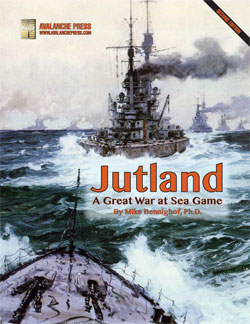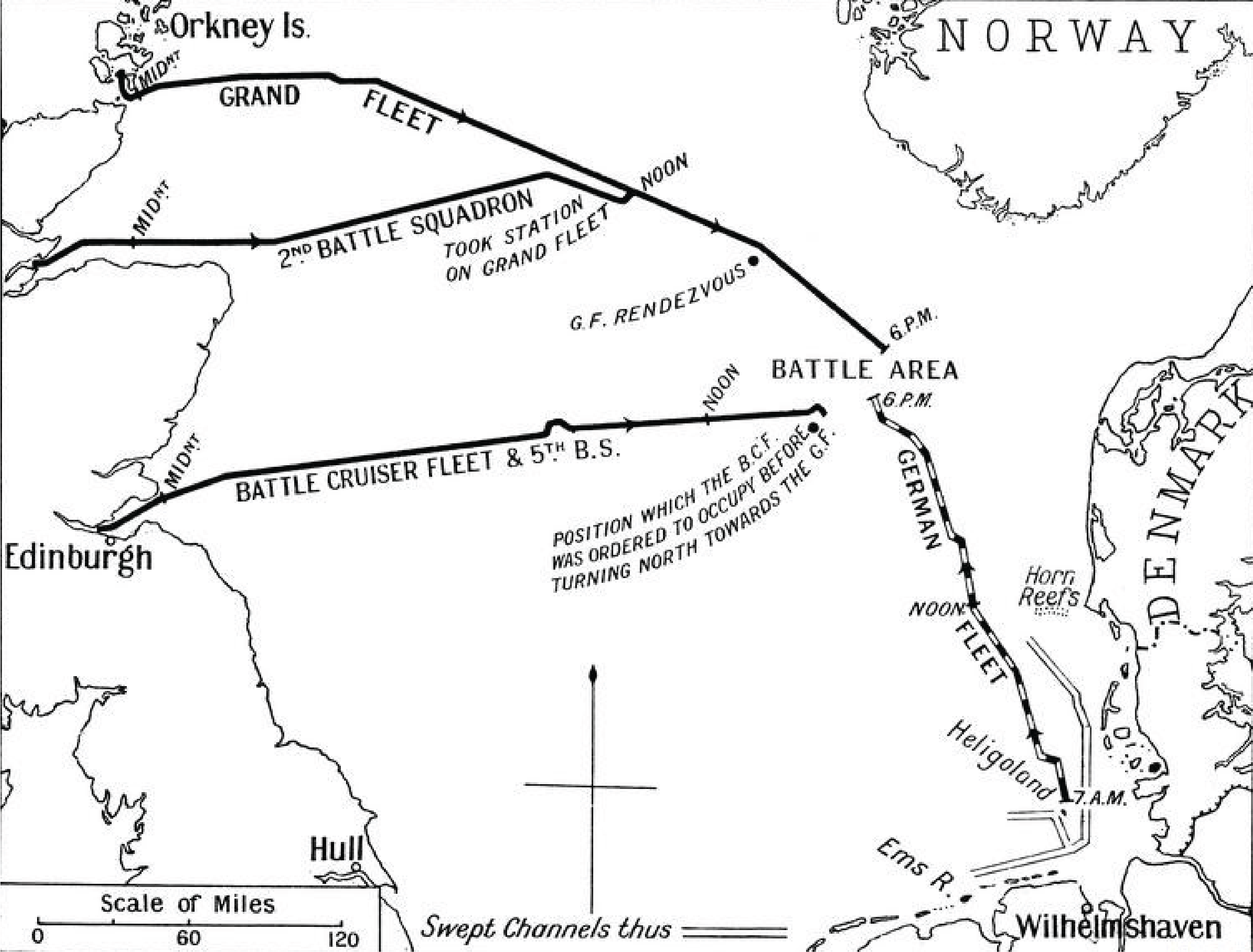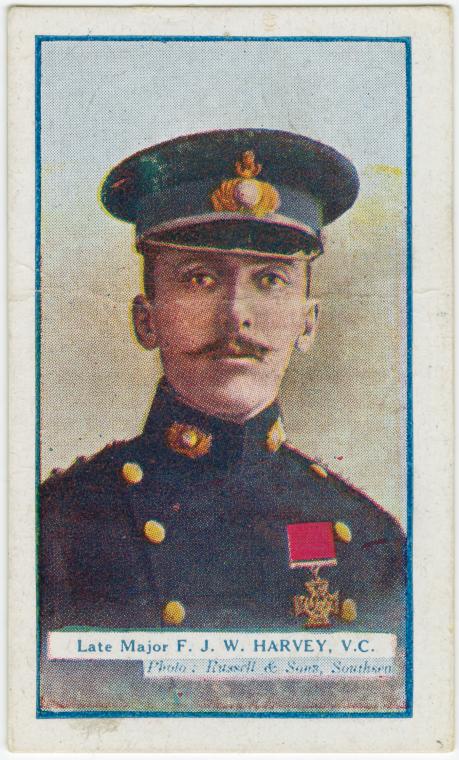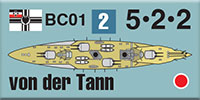| Jutland:
The Battle, Part Two:
Battle Cruiser Clash
By Mike Bennighof, Ph.D.
May 2024
 The first elements of the German High Seas Fleet – the battle cruisers of 1st Scouting Group and light cruisers and torpedo boats of 2nd Scouting Group – had cleared the minefields outside the German bases and headed north by 0900. At that point the British battle cruisers had already left port and were on their way across the North Sea at their commander David Beatty’s preferred speed, 18 knots. While his fastest ships could make 29 knots, his coal-fired ships (which included all of his battle cruisers) were stoked by hand, and Beatty thought it important to reserve their stamina for when it would be truly needed, once contact had been made with the Germans. The first elements of the German High Seas Fleet – the battle cruisers of 1st Scouting Group and light cruisers and torpedo boats of 2nd Scouting Group – had cleared the minefields outside the German bases and headed north by 0900. At that point the British battle cruisers had already left port and were on their way across the North Sea at their commander David Beatty’s preferred speed, 18 knots. While his fastest ships could make 29 knots, his coal-fired ships (which included all of his battle cruisers) were stoked by hand, and Beatty thought it important to reserve their stamina for when it would be truly needed, once contact had been made with the Germans.
German submarines sighted the Battle Cruiser Fleet as it left port, and also the 2nd Battle Squadron departing Cromarty Firth. They were unable to score any torpedo hits, but did radio the information back to fleet headquarters. British practice called for major fleet units to zig-zag in dangerous waters, and the u-boats reported the enemy to be proceeding on divergent courses when actually they were headed for a mid-North-Sea rendezvous. Because of high winds, the zeppelins intended to give the Germans a scouting advantage did not take to the air until 1230.
Contact came at 1520, when a pair of German torpedo boats and a pair of British light cruisers, dispatched to investigate a neutral Danish steamer, spotted one another. Eight minutes later the British cruiser Galatea fired the battle’s first shots, and eight minutes after that she received the battle’s first hit, from the German light cruiser Elbing, but the shell did not explode. Galatea mistook the smoke of the Second Scouting Group for the entire High Seas Fleet and reported it so, giving Jellicoe his first inkling that the Germans were at sea.

Beatty’s 1st and 2nd Battle Cruiser Squadrons came on in two parallel columns, with the 5th Battle Squadron (four Queen Elizabeth-class super-dreadnoughts armed with 15-inch guns) lagging behind thanks to a signals misunderstanding. They closed on the light cruisers from the west, while Hipper and his five battle cruisers, deployed in single file, did so from the east. Hipper was well aware of Beatty’s superior numbers and firepower, but ordered his ships to clear for action and increase speed. While his officers and crew interpreted those orders as a thirst for battle, they also allowed him to close with and support his exposed light cruisers. Meanwhile, Hipper informed Scheer of the contact and his response, and Scheer ordered the Hugh Seas Fleet’s main body to make “All Speed” to join the battle cruisers.
Beatty would later claim to have placed his ships between Hipper and the German bases, but this was not true. The four “Splendid Cats” of Beatty’s 1st Battle Cruiser Squadron had 13.5-inch guns with a sizeable range advantage over all of the German ships, and Hipper sought to steam as quickly as possible through the zone where the British could hit his ships but the Germans could not strike back. The Germans then turned about to keep the range where Hipper wished, their single column of battle cruisers now headed south-east. Flagship Lützow led the battle line, followed by her sister Derfflinger, then Seydlitz, Moltke and von der Tann.
Lützow opened fire at 1648. Beatty’s ships had now fanned out and approached in a line, limiting them to fire from their forward turrets only while the Germans could use all of their heavy guns (at least those ships able to fire a full broadside). The British soon turned to match the German course, beginning what would be known as the “Run to the South,” with flagship Lion at the front, followed by her sisters Princess Royal and Queen Mary, then Tiger and lastly the two much weaker ships of 2nd Battle Cruiser Squadron, New Zealand and Indefatigable. The opposing ships paired off to fight individual duels. Two British ships fired at Lützow and later Moltke; for a time, no one fired at Derfflinger.
At 1703, three shells from von der Tann struck Indefatigable near her aftmost turret, causing her to slow and sheer out of line, when two more struck her around her forward turret. Within thirty seconds she went up in a massive blast, apparently having suffered explosions of both her forward and after magazines. Of the 1,019 officers and men aboard, two would be picked up by a German torpedo boat. They had manned the signal top and once in the water found their badly-wounded captain, C.F. Sowerby; they kept him afloat but he died before their rescue.
 The Germans, upwind from the British, had their smoke blown away by the stiff breeze while British gunnery was fouled by heavy coal smoke as all of the ships made speed. German gunnery continued to score, and at 1700 a shell from Lützow struck Lion’s Q (amidship) turret just above the left 13.5-inch gun, exploding within and instantly killing the gun crew and everyone in the handling room just below the turret. The magazine walls below buckled, and had the armored shell-handling doors been open to speed the supply of ammunition to the big guns (as was almost certainly the case in the doomed Indefatigable), Lion would have gone up in a similar explosion. With his dying breaths, Marine Maj. Francis J.W. Harvey ordered the magazine flooded, saving the ship. The Germans, upwind from the British, had their smoke blown away by the stiff breeze while British gunnery was fouled by heavy coal smoke as all of the ships made speed. German gunnery continued to score, and at 1700 a shell from Lützow struck Lion’s Q (amidship) turret just above the left 13.5-inch gun, exploding within and instantly killing the gun crew and everyone in the handling room just below the turret. The magazine walls below buckled, and had the armored shell-handling doors been open to speed the supply of ammunition to the big guns (as was almost certainly the case in the doomed Indefatigable), Lion would have gone up in a similar explosion. With his dying breaths, Marine Maj. Francis J.W. Harvey ordered the magazine flooded, saving the ship.
Her sister ship, Queen Mary, would not be so fortunate. Several hits from Seydlitz amidships at 1721 caused a fire in her 4-inch magazines, followed quickly by two more from Derfflinger at 1726 on her A (foremost) turret). The ship at first staggered and lost power, and an explosion broke in her in half. Moments later, as New Zealand passed close by the wreck, a second explosion blew apart the after half of the sinking ship. Of her 1,286 officers and men, 18 would be saved by British destroyers and two more by German torpedo boats.
“There seems to be something wrong with our bloody ships today,” Beatty told his flag captain, Ernle Chatfield, as the remains of Queen Mary disappeared, “or with our system.”
Hipper briefly had the advantage, with five ships to Beatty’s four, until help arrived to swing the balance dramatically in Beatty’s favor. Rear Admiral Hugh Evan-Thomas had led his 5th Battle Squadron off to the north-east for several minutes after Beatty turned his battle cruisers toward the Germans, the flag signals not having been seen in his flagship Barham. After watching the battle cruisers continue to the south-east, on his own initiative – a career-endangering move, given the Royal Navy’s “cult of the senior officer present” – Evan-Thomas ordered his four super-dreadnoughts to follow them.
The battleships caught up with the British line and Barham opened fire at 1706, scoring her first hit on Moltke at 1716. Two of the battleships fired on Moltke and the other two at von der Tann, blazing away with impunity as the 280mm (11-inch) guns on the two German ships could not reach them.

Queen Mary (right) explodes while Lion (left) steams through German shell splashes.
As the range closed, the Germans could finally fire at the battleships, while the big British guns obtained relatively few hits. Even so, von der Tann was soon down to two working 280mm guns with two turrets damaged and a third out of action thanks to overheated gun barrels. Her gunnery officer, Erich Mahrholz, thought his ship extremely lucky to survive:
“The nearby torpedo boats reported that during this phase of the battle the ship could scarcely be seen among the many impacts, and when the veil parted it was a wonder that the ship was seen afloat.”
With the High Seas Fleet approaching, Hipper now tried to close the range despite being outnumbered 8:5 in number of ships and outgunned by a much wider margin. His aggression was immediately rewarded by a torpedo strike on Seydlitz from a British destroyer; her crew quickly contained the damage and the battle cruiser lost no speed.
Beatty soon had an explanation for the seemingly insane German maneuver, when the light cruiser Southampton at 1740 reported massive smoke clouds approaching. At 1746 Beatty turned his battle cruisers back toward the approaching Grand Fleet at high speed, but failed to inform Evan-Thomas, who once again followed on his own initiative at 1754.
Princess Royal passed on the scouting report at 1745, as Lion’s wireless had broken down; until then, Jellicoe had assumed the bulk of the High Seas Fleet to have remained in Wilhelmshaven thanks to the swap of radio call signs. This battle would not be a replay of Dogger Bank.
The story continues in Part Three.
Order Jutland second edition here.
The Jutland Experience
 Jutland Second Edition (full game) Jutland Second Edition (full game)
Jutland: North Sea 1914
Jutland: Dogger Bank
Journal No. 46: Iron Dogs
Retail Price: $179.96
Package Price: $150.00
Gold Club Price: $120.00
You can order the Jutland Experience right here.
Sign up for our newsletter right here. Your info will never be sold or transferred; we'll just use it to update you on new games and new offers.
Mike Bennighof is president of Avalanche Press and holds a doctorate in history from Emory University. A Fulbright Scholar and NASA Journalist in Space finalist, he has published a great many books, games and articles on historical subjects; people are saying that some of them are actually good.
He lives in Birmingham, Alabama with his wife, three children, and his new puppy. His Iron Dog, Leopold, could swim very well.
Want to keep Daily Content free of third-party ads? You can send us some love (and cash) through this link right here.
|
